Abstract
We have identified 39 individuals with anti-centromere antibodies (ACA) in our patient population, all of whom have Raynaud's syndrome or disease. We have used sera from the ACA-positive patients and from 123 controls (22 normal individuals and 101 additional patients with either Raynaud's disease or Raynaud's syndrome plus an associated connective tissue disease) to screen the proteins of highly purified human (HeLa) mitotic chromosomes by sodium dodecyl sulfate polyacrylamide gel electrophoresis and immunoblotting. Three antigens were recognized by the sera from the ACA-positive patients. These were centromere protein (CENP)-B (80,000 mol wt--recognized by all ACA-positive sera), CENP-A (17,000 mol wt--recognized by 38 of 39 ACA-positive sera), and CENP-C (140,000 mol wt--recognized by 37 of 39 ACA-positive sera). None of these antigens were recognized by any of the 123 control sera, although binding was occasionally seen to other chromosomal antigens. Therefore the ACA response is highly uniform in our patient population. Antibody to CENP-B shows a 100% correlation with anti-centromere staining by indirect immunofluorescence.
Full text
PDF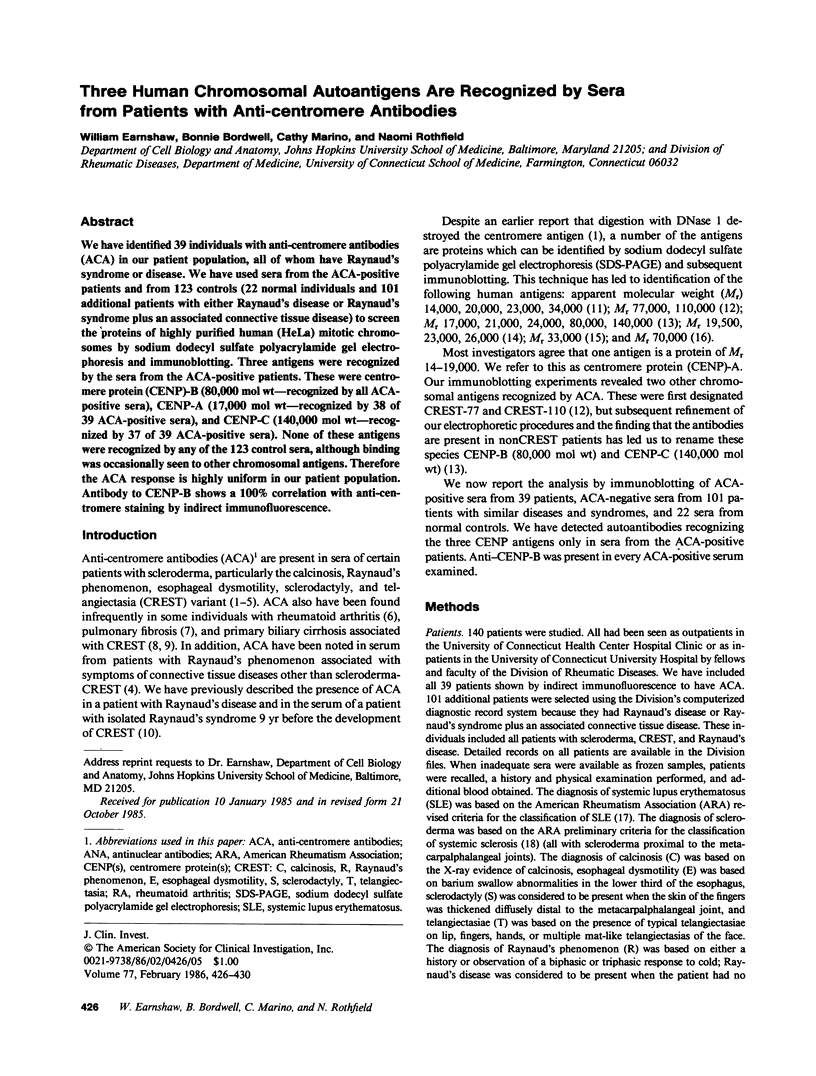
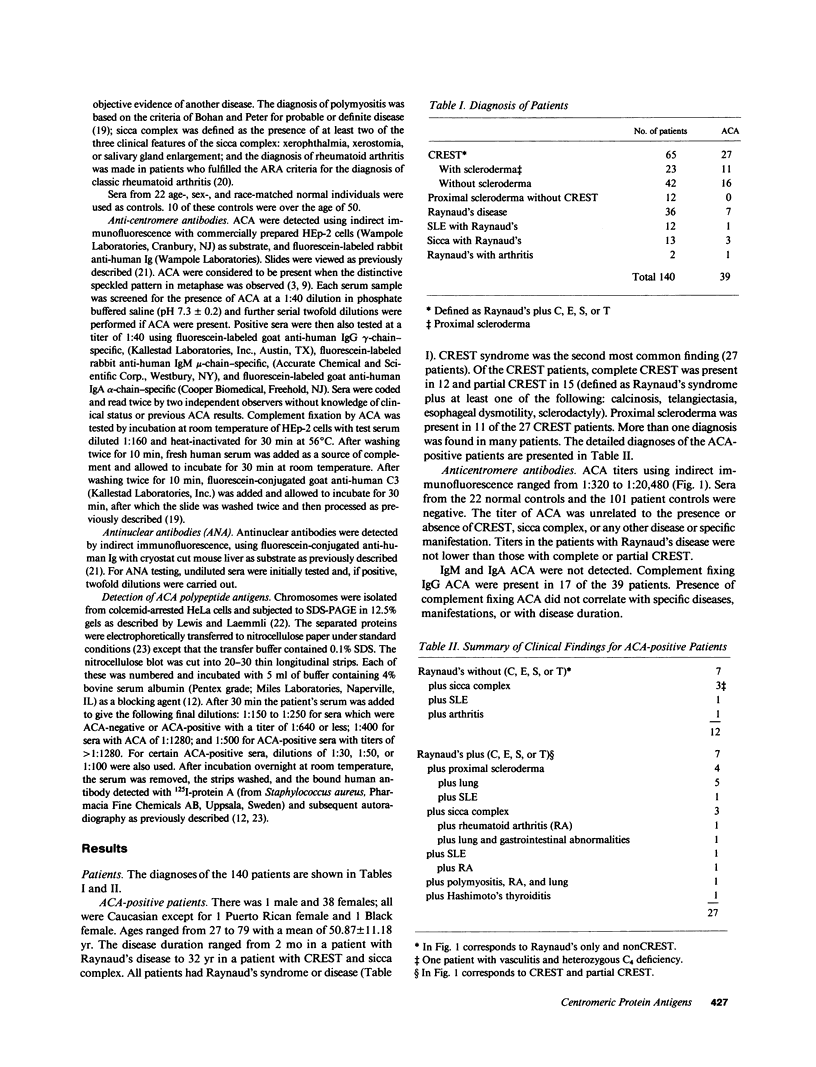
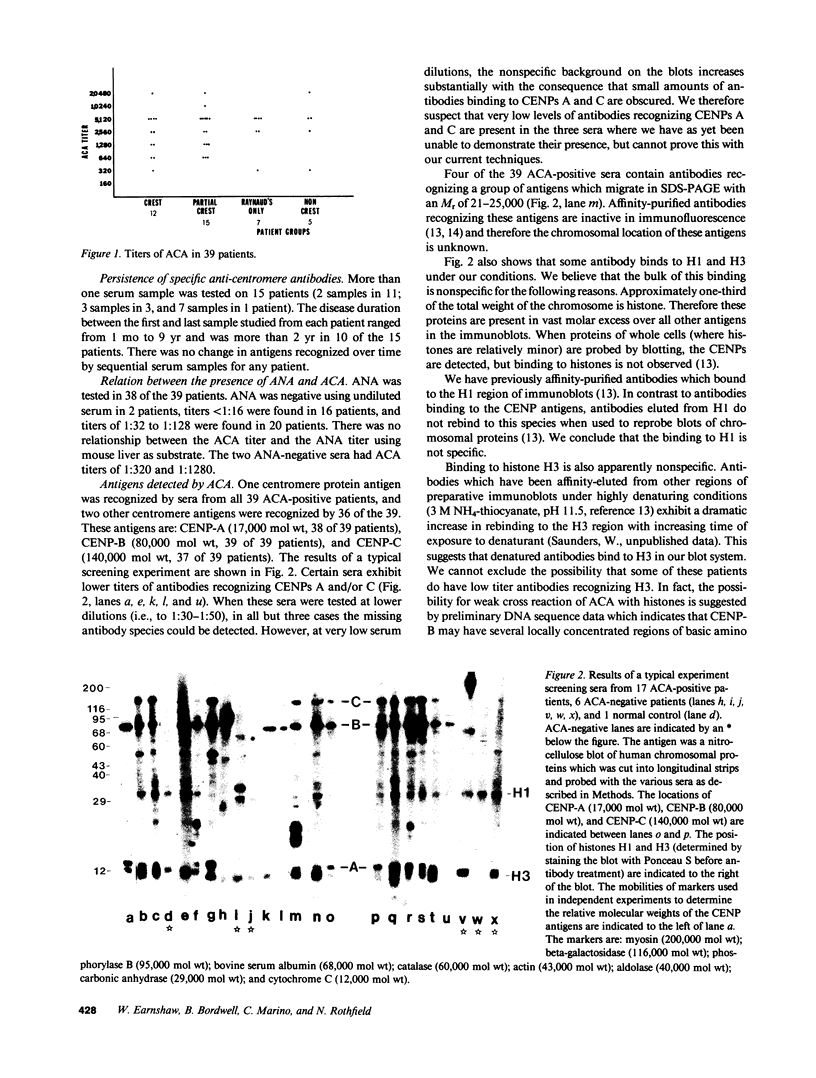
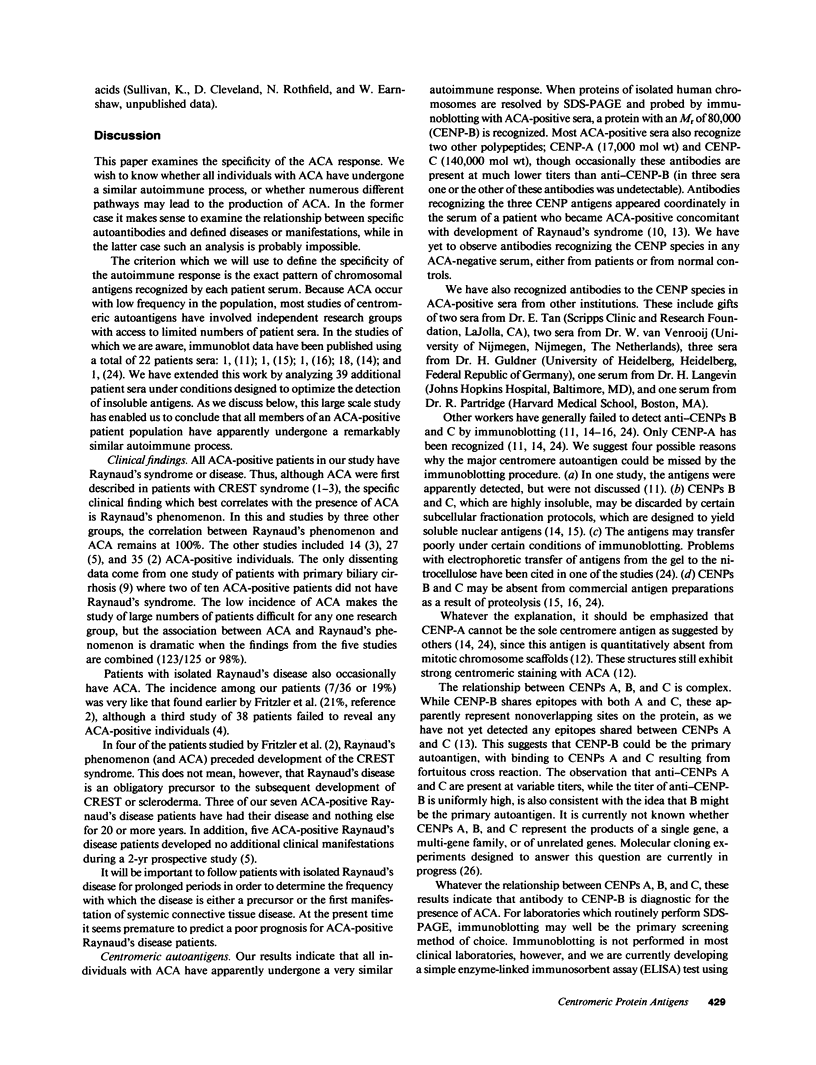
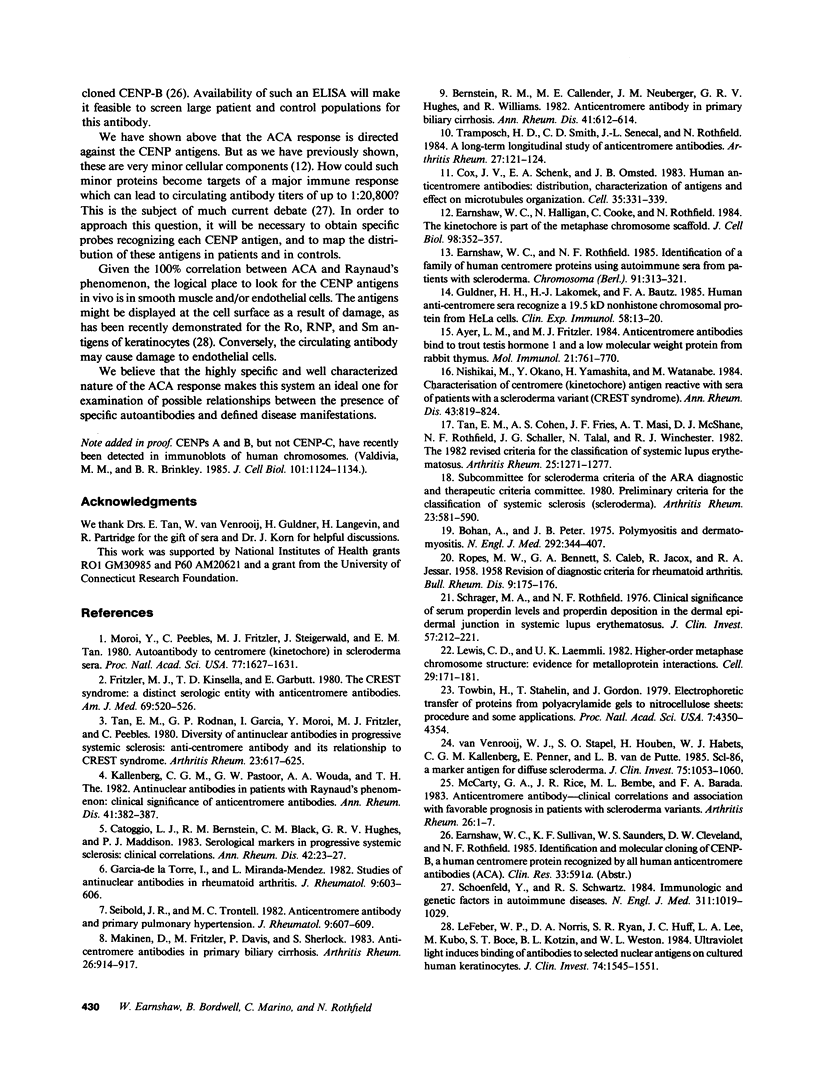
Images in this article
Selected References
These references are in PubMed. This may not be the complete list of references from this article.
- Ayer L. M., Fritzler M. J. Anticentromere antibodies bind to trout testis histone 1 and a low molecular weight protein from rabbit thymus. Mol Immunol. 1984 Sep;21(9):761–770. doi: 10.1016/0161-5890(84)90162-7. [DOI] [PubMed] [Google Scholar]
- Bernstein R. M., Callender M. E., Neuberger J. M., Hughes G. R., Williams R. Anticentromere antibody in primary biliary cirrhosis. Ann Rheum Dis. 1982 Dec;41(6):612–614. doi: 10.1136/ard.41.6.612. [DOI] [PMC free article] [PubMed] [Google Scholar]
- Bohan A., Peter J. B. Polymyositis and dermatomyositis (first of two parts). N Engl J Med. 1975 Feb 13;292(7):344–347. doi: 10.1056/NEJM197502132920706. [DOI] [PubMed] [Google Scholar]
- Catoggio L. J., Bernstein R. M., Black C. M., Hughes G. R., Maddison P. J. Serological markers in progressive systemic sclerosis: clinical correlations. Ann Rheum Dis. 1983 Feb;42(1):23–27. doi: 10.1136/ard.42.1.23. [DOI] [PMC free article] [PubMed] [Google Scholar]
- Cox J. V., Schenk E. A., Olmsted J. B. Human anticentromere antibodies: distribution, characterization of antigens, and effect on microtubule organization. Cell. 1983 Nov;35(1):331–339. doi: 10.1016/0092-8674(83)90236-2. [DOI] [PubMed] [Google Scholar]
- Earnshaw W. C., Halligan N., Cooke C., Rothfield N. The kinetochore is part of the metaphase chromosome scaffold. J Cell Biol. 1984 Jan;98(1):352–357. doi: 10.1083/jcb.98.1.352. [DOI] [PMC free article] [PubMed] [Google Scholar]
- Earnshaw W. C., Rothfield N. Identification of a family of human centromere proteins using autoimmune sera from patients with scleroderma. Chromosoma. 1985;91(3-4):313–321. doi: 10.1007/BF00328227. [DOI] [PubMed] [Google Scholar]
- Fritzler M. J., Kinsella T. D. The CREST syndrome: a distinct serologic entity with anticentromere antibodies. Am J Med. 1980 Oct;69(4):520–526. doi: 10.1016/0002-9343(80)90462-3. [DOI] [PubMed] [Google Scholar]
- Garcia-de la Torre I., Miranda-Mendez L. Studies of antinuclear antibodies in rheumatoid arthritis. J Rheumatol. 1982 Jul-Aug;9(4):603–606. [PubMed] [Google Scholar]
- Guldner H. H., Lakomek H. J., Bautz F. A. Human anti-centromere sera recognise a 19.5 kD non-histone chromosomal protein from HeLa cells. Clin Exp Immunol. 1984 Oct;58(1):13–20. [PMC free article] [PubMed] [Google Scholar]
- Kallenberg C. G., Pastoor G. W., Wouda A. A., The T. H. Antinuclear antibodies in patients with Raynaud's phenomenon: clinical significance of anticentromere antibodies. Ann Rheum Dis. 1982 Aug;41(4):382–387. doi: 10.1136/ard.41.4.382. [DOI] [PMC free article] [PubMed] [Google Scholar]
- LeFeber W. P., Norris D. A., Ryan S. R., Huff J. C., Lee L. A., Kubo M., Boyce S. T., Kotzin B. L., Weston W. L. Ultraviolet light induces binding of antibodies to selected nuclear antigens on cultured human keratinocytes. J Clin Invest. 1984 Oct;74(4):1545–1551. doi: 10.1172/JCI111569. [DOI] [PMC free article] [PubMed] [Google Scholar]
- Lewis C. D., Laemmli U. K. Higher order metaphase chromosome structure: evidence for metalloprotein interactions. Cell. 1982 May;29(1):171–181. doi: 10.1016/0092-8674(82)90101-5. [DOI] [PubMed] [Google Scholar]
- Makinen D., Fritzler M., Davis P., Sherlock S. Anticentromere antibodies in primary biliary cirrhosis. Arthritis Rheum. 1983 Jul;26(7):914–917. doi: 10.1002/art.1780260714. [DOI] [PubMed] [Google Scholar]
- McCarty G. A., Rice J. R., Bembe M. L., Barada F. A., Jr Anticentromere antibody. Clinical Correlations and association with favorable prognosis in patients with scleroderma variants. Arthritis Rheum. 1983 Jan;26(1):1–7. doi: 10.1002/art.1780260101. [DOI] [PubMed] [Google Scholar]
- Moroi Y., Peebles C., Fritzler M. J., Steigerwald J., Tan E. M. Autoantibody to centromere (kinetochore) in scleroderma sera. Proc Natl Acad Sci U S A. 1980 Mar;77(3):1627–1631. doi: 10.1073/pnas.77.3.1627. [DOI] [PMC free article] [PubMed] [Google Scholar]
- Nishikai M., Okano Y., Yamashita H., Watanabe M. Characterisation of centromere (kinetochore) antigen reactive with sera of patients with a scleroderma variant (CREST syndrome). Ann Rheum Dis. 1984 Dec;43(6):819–824. doi: 10.1136/ard.43.6.819. [DOI] [PMC free article] [PubMed] [Google Scholar]
- ROPES M. W., BENNETT G. A., COBB S., JACOX R., JESSAR R. A. 1958 Revision of diagnostic criteria for rheumatoid arthritis. Bull Rheum Dis. 1958 Dec;9(4):175–176. [PubMed] [Google Scholar]
- Schrager M. A., Rothfield N. F. Clinical significance of serum properdin levels and properdin deposition in the dermal-epidermal junction in systemic lupus erythematosus. J Clin Invest. 1976 Jan;57(1):212–221. doi: 10.1172/JCI108262. [DOI] [PMC free article] [PubMed] [Google Scholar]
- Seibold J. R., Trontell M. C. Anticentromere antibody and primary pulmonary hypertension. J Rheumatol. 1982 Jul-Aug;9(4):607–609. [PubMed] [Google Scholar]
- Shoenfeld Y., Schwartz R. S. Immunologic and genetic factors in autoimmune diseases. N Engl J Med. 1984 Oct 18;311(16):1019–1029. doi: 10.1056/NEJM198410183111605. [DOI] [PubMed] [Google Scholar]
- Tan E. M., Cohen A. S., Fries J. F., Masi A. T., McShane D. J., Rothfield N. F., Schaller J. G., Talal N., Winchester R. J. The 1982 revised criteria for the classification of systemic lupus erythematosus. Arthritis Rheum. 1982 Nov;25(11):1271–1277. doi: 10.1002/art.1780251101. [DOI] [PubMed] [Google Scholar]
- Tan E. M., Rodnan G. P., Garcia I., Moroi Y., Fritzler M. J., Peebles C. Diversity of antinuclear antibodies in progressive systemic sclerosis. Anti-centromere antibody and its relationship to CREST syndrome. Arthritis Rheum. 1980 Jun;23(6):617–625. doi: 10.1002/art.1780230602. [DOI] [PubMed] [Google Scholar]
- Towbin H., Staehelin T., Gordon J. Electrophoretic transfer of proteins from polyacrylamide gels to nitrocellulose sheets: procedure and some applications. Proc Natl Acad Sci U S A. 1979 Sep;76(9):4350–4354. doi: 10.1073/pnas.76.9.4350. [DOI] [PMC free article] [PubMed] [Google Scholar]
- Tramposch H. D., Smith C. D., Senecal J. L., Rothfield N. A long-term longitudinal study of anticentromere antibodies. Arthritis Rheum. 1984 Feb;27(2):121–124. doi: 10.1002/art.1780270201. [DOI] [PubMed] [Google Scholar]
- Valdivia M. M., Brinkley B. R. Fractionation and initial characterization of the kinetochore from mammalian metaphase chromosomes. J Cell Biol. 1985 Sep;101(3):1124–1134. doi: 10.1083/jcb.101.3.1124. [DOI] [PMC free article] [PubMed] [Google Scholar]
- van Venrooij W. J., Stapel S. O., Houben H., Habets W. J., Kallenberg C. G., Penner E., van de Putte L. B. Scl-86, a marker antigen for diffuse scleroderma. J Clin Invest. 1985 Mar;75(3):1053–1060. doi: 10.1172/JCI111767. [DOI] [PMC free article] [PubMed] [Google Scholar]



